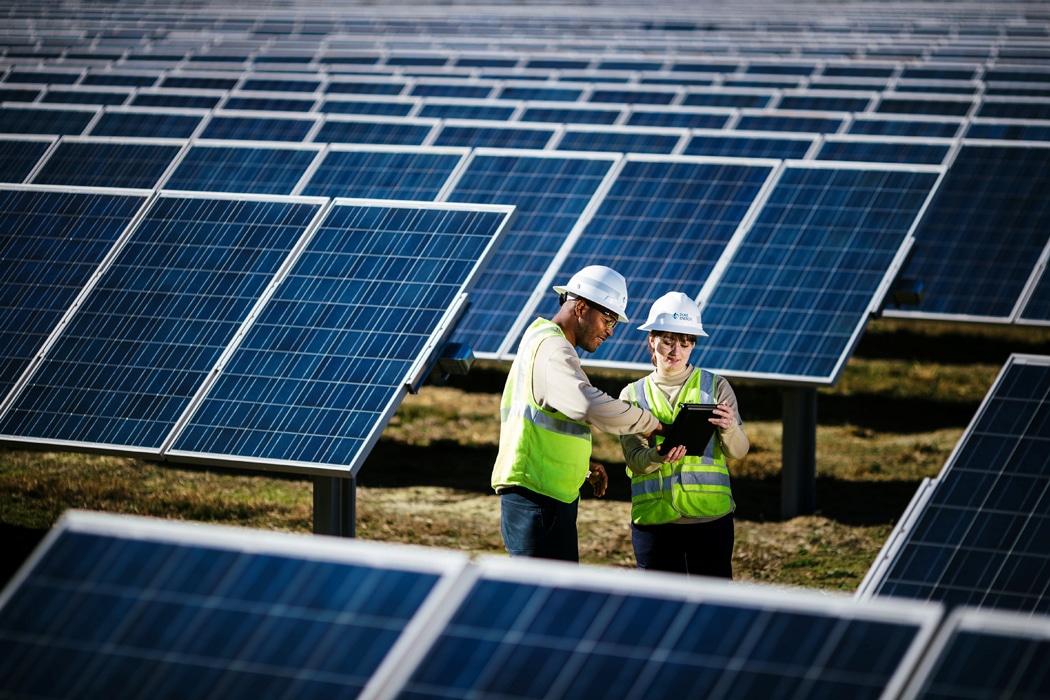In addition to the standard three dimensions of reality—length, width, and height—John Burnett wrestles daily with the fourth dimension: time.
As deputy general counsel for Duke Energy, he must constantly be thinking about the past, present, and future, all of which overlap and interact. What happened forty years ago and what will happen forty years from now all play into the regional energy giant’s decisions and actions today.
The company’s past, Burnett says, includes an electrical grid largely built over many decades of the twentieth century. The thousands of miles of aging high-voltage transmission lines, plus substations that step down that voltage to a level that can be used by homes and businesses, are essential to modern life. But, the nation’s grid system is challenged by new threats and evolving opportunities.
And, because coal was a primary fuel for electricity generation in the twentieth century—and remains a source for roughly a third of generation today—millions of tons of residual ash, a waste by-product, linger in various storage facilities across the country.

This is where the past melds into the present. Many companies, including Duke, have continued to evolve their practices, adding new technology to ensure that coal ash continues to be managed in a way that is safe for the public and surrounding environment. “To give you an example of how technology has changed, decades ago, coal ash was released into the air with other emissions,” Burnett says. “New equipment was added to capture it, then the material was stored in coal-ash basins. Today we’ve moved to dry, lined storage solutions and are retiring basins.”
As the industry has evolved, so has coal-ash regulation. “These regulations require closing down the unlined basins by safely capping them in place, excavating the material, or even recycling it,” Burnett says. “It can be used in ultra-hard premium concrete, turning waste into valuable construction material.”
As a lead attorney, Burnett has to satisfy several constituencies in helping determine how the ash is safely managed. “We have to show state environmental regulators that we are being compliant with the law,” he says. “But I also have to show energy regulators that we are being reasonable and prudent with the economics of this disposal.” Both the environmental and economic factors have a direct impact on energy consumers as well.
Similarly, Burnett’s help with Duke’s grid modernization also requires the consideration of stakeholders with different interests, including utility regulators, environmental watchdogs, legislators, and end users. Originally, Duke conceived a plan titled “Power/Forward Carolinas,” a ten-year project proposed in 2017 and slated to cost almost $16 billion. Among other things, the plan was intended to harden the grid against extreme weather and cyberattacks, help expand renewable-energy production with energy-storage projects, and stimulate jobs and local economic activity.
State energy regulators did not approve Duke’s original plan, but Burnett and his colleagues are determined to find solutions by working with stakeholders. “It was a ten-year view,” Burnett says. “Our regulators liked it in spirit, but ten years is a long time out, and it was a lot of money. The message we got was to rethink it.”
The rethinking entails taking a three-year approach. The plan’s priorities still include grid protection from cyberattacks and natural disasters; the optimization of assets, with heavy cost-benefit analysis; and overall modernization—but only for the essentials. The reason for this, as Burnett explains it, is that it’s very hard to predict what the needs and technologies will be in 2029. “‘No change’ will not work,” he says. “But, to imagine we’ll go 100 percent solar that quickly is not likely either. We have to keep our options open and balanced.”
“‘No change’ will not work. But, to imagine we’ll go 100 percent solar that quickly is not likely either. We have to keep our options open and balanced.”
The rapid pace of technological change everywhere, particularly in energy, is the driver behind Duke’s strategy. “Consider the rapid transformation in the past ten years,” Burnett says. “With shale gas, the renewable-tech boom, and energy storage on the horizon, this is very much about change that benefits our customers.”
Among the innovations he does think can be adopted in the next three years or so are Integrated Volt/VAR Control systems, which will help smooth out the production peaks and valleys of renewables such as wind and solar. It’s a beneficial technology that will require support from people in the political, financial, scientific, and societal sectors. “We can’t solve all our problems in a vacuum,” Burnett says. “We need to find a coalescence of view.” He and his colleagues have already begun to work on this, including through a set of workshops involving such parties as the Sierra Club and the American Association of Retired Persons.
A military veteran with six years and two tours of duty in Iraq under his belt, Burnett is a strong believer in collaboration, and to this end, he says, he operates as one-third lawyer and two-thirds businessperson. “There were sandstorms and 120-degree temperatures in Iraq,” he says. “What I learned was the importance of teams—and to be strategic.”
With such values in mind, Burnett will be able to continue handling all of Duke’s opportunities—electricity generation, storage, transmission, and waste disposal—from every dimension.


